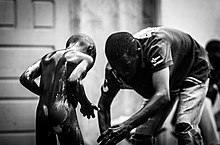Hygiene


Hygieneis the act of beingclean.Washing the body to removedirtandgerms,brushing the teethto keep them clean,shaving,using thetoiletproperly, anddressingcorrectly are some examples. Proper hygiene is often taught to children at a young age, and it becomes a habit. People who do not have good hygiene might smell bad, lose teeth, or becomeill(sick).[1]
First proven use of the word in English was in 1677s. The word hygiene comes from the French word hygiène, which is the western version of Greek word ὑγιεινή (τέχνη) - hugieinē technē, meaning "(art) of health", from ὑγιεινός (hugieinos), "good for the health, healthy",[2]in turn from ὑγιής (hugiēs), "healthful, sound, salutary, wholesome". In ancientGreek religion,Hygeia (Ὑγίεια) was the daughter ofAsclepiusand represented health.
Related pages
[change|change source]References
[change|change source]- ↑"Instrukcja mycia rąk - oświata, handel, zakłady i instytucje".Archived fromthe originalon 2015-04-14.Retrieved2013-04-11.
- ↑"Henry George Liddell, Robert Scott, A Greek-English Lexicon, ὑγι-εινός".perseus.tufts.edu.
